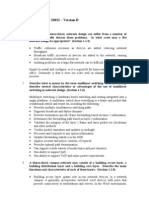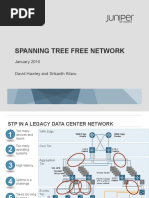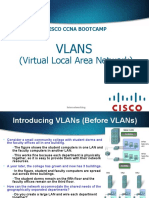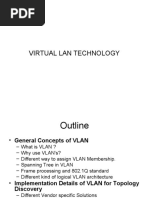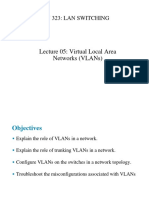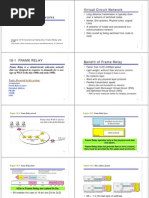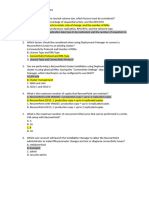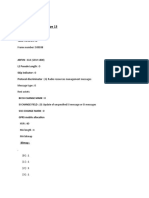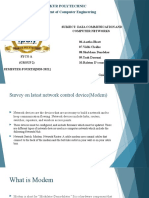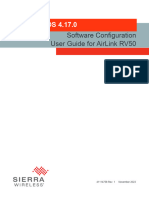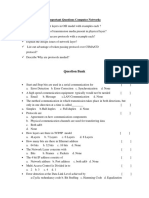0 ratings0% found this document useful (0 votes)
28 viewsSwitch Stacking12
Switch Stacking12
Uploaded by
LadislauThis document compares the features of switch stacking, LAG, and VLT technologies. LAG combines links between two switches into a single logical link to increase bandwidth utilization and availability. VLT provides higher resiliency with dual control planes and gives link redundancy between two peers. Switch stacking allows multiple physical switches to act as a single virtual switch, simplifying management and providing resiliency through automatic failover, but maintenance requires rebooting the entire fabric.
Copyright:
© All Rights Reserved
Available Formats
Download as PDF, TXT or read online from Scribd
Switch Stacking12
Switch Stacking12
Uploaded by
Ladislau0 ratings0% found this document useful (0 votes)
28 views1 pageThis document compares the features of switch stacking, LAG, and VLT technologies. LAG combines links between two switches into a single logical link to increase bandwidth utilization and availability. VLT provides higher resiliency with dual control planes and gives link redundancy between two peers. Switch stacking allows multiple physical switches to act as a single virtual switch, simplifying management and providing resiliency through automatic failover, but maintenance requires rebooting the entire fabric.
Original Description:
save
Copyright
© © All Rights Reserved
Available Formats
PDF, TXT or read online from Scribd
Share this document
Did you find this document useful?
Is this content inappropriate?
This document compares the features of switch stacking, LAG, and VLT technologies. LAG combines links between two switches into a single logical link to increase bandwidth utilization and availability. VLT provides higher resiliency with dual control planes and gives link redundancy between two peers. Switch stacking allows multiple physical switches to act as a single virtual switch, simplifying management and providing resiliency through automatic failover, but maintenance requires rebooting the entire fabric.
Copyright:
© All Rights Reserved
Available Formats
Download as PDF, TXT or read online from Scribd
Download as pdf or txt
0 ratings0% found this document useful (0 votes)
28 views1 pageSwitch Stacking12
Switch Stacking12
Uploaded by
LadislauThis document compares the features of switch stacking, LAG, and VLT technologies. LAG combines links between two switches into a single logical link to increase bandwidth utilization and availability. VLT provides higher resiliency with dual control planes and gives link redundancy between two peers. Switch stacking allows multiple physical switches to act as a single virtual switch, simplifying management and providing resiliency through automatic failover, but maintenance requires rebooting the entire fabric.
Copyright:
© All Rights Reserved
Available Formats
Download as PDF, TXT or read online from Scribd
Download as pdf or txt
You are on page 1of 1
CRE https://cloudplayer.bravais.com/preview?p=kRTsMajAj4PrGZy5Sgp1gf6f0DZsjMMOZqafYdE3WuU1pJ/QtvWRcWp4TsLhlQpgVT+sJV8fG...
Comparing Switch Stacking to Other Technologies
This table compares the switch stacking feature to LAG and VLT technology.
Feature Description Bene�ts Drawbacks Topology diagram
• Overcomes limitations of Spanning
Tree Protocol (STP) by eliminating
Link Aggregation Group: the need to block interfaces
Implemented with Link Aggregation Control • Increases bandwidth utilization
Protocol—LACP —balances tra�c across all member
LAG links Peer-to-peer only
Combines links between two switches into • Increased availability—If one
single logical link. member fails, the remaining
members in the LAG continue to
carry tra�c
• Higher resiliency with dual control
plane
• Gives link redundancy - both VLT
links are active, but do not form a
Virtual Link Trunking: loop
Multichassis Link Aggregation where • Optimal bandwidth utilization
VLT Limited to 2 peers
downstream devices build port channels to a
• Automatic failover if there is failure
single logical chassis
• Switches operate as independent
L2/L3 switches
• Maintenance on one switch without
taking down the entire fabric
• Single Control Plane
• Simpli�es management Maintenance “lights
• Provides resiliency – automatic out” required – a
Virtual chassis – multiple physical switches failover reboot is needed after
Stacking
make up one virtual switch. �rmware upgrade
• Supports multiple topologies takes down entire
• Supports two or more chassis fabric.
(up to 12 with some Dell switches)
1 de 1 27/10/2022, 12:20
You might also like
- PowerMaxOS 10 Installation - Participant GuideDocument107 pagesPowerMaxOS 10 Installation - Participant GuideLadislauNo ratings yet
- PowerStore+Concepts+and+Features+ +Participant+Guide (PDF) +Document72 pagesPowerStore+Concepts+and+Features+ +Participant+Guide (PDF) +LadislauNo ratings yet
- Dell EMC Unity XT Hardware Concepts and Features-SSP - Participant GuideDocument98 pagesDell EMC Unity XT Hardware Concepts and Features-SSP - Participant GuideLadislau100% (1)
- Jn0 648 FormattedDocument48 pagesJn0 648 Formattedsyed yasir gilaniNo ratings yet
- Isilon - PowerScale - OneFS Upgrade-OneFS 8.x and 9.x Upgrade and Planning Process GuideDocument72 pagesIsilon - PowerScale - OneFS Upgrade-OneFS 8.x and 9.x Upgrade and Planning Process GuideLadislauNo ratings yet
- Vxrail Customer Presentation 2Document36 pagesVxrail Customer Presentation 2LadislauNo ratings yet
- Dell EMC Unity Concepts and Features - Participant GuideDocument104 pagesDell EMC Unity Concepts and Features - Participant GuideLadislauNo ratings yet
- Question Bank D 32011Document14 pagesQuestion Bank D 32011EdencbNo ratings yet
- FDD Lte Air Scale Fl16aDocument18 pagesFDD Lte Air Scale Fl16aArrul Insani100% (3)
- CN PPT-Unit IDocument63 pagesCN PPT-Unit ISashikanth BethaNo ratings yet
- HP Switching and Routing Technologies: Web-Based Training Course CompanionDocument102 pagesHP Switching and Routing Technologies: Web-Based Training Course CompanionivanovNo ratings yet
- Arctica-4804ip-V 1 2Document1 pageArctica-4804ip-V 1 2david.cathcartNo ratings yet
- Layer 2 Network Design: Carlos Vicente University of Oregon Cvicente@uoregon - EduDocument103 pagesLayer 2 Network Design: Carlos Vicente University of Oregon Cvicente@uoregon - Eduobee1234No ratings yet
- Spanning Tree Free Network: January 2010 David Hawley and Srikanth KilaruDocument11 pagesSpanning Tree Free Network: January 2010 David Hawley and Srikanth Kilarugaurav_sethiNo ratings yet
- Campus Networking Workshop: Layer-2 Network DesignDocument101 pagesCampus Networking Workshop: Layer-2 Network DesignTsega TeklewoldNo ratings yet
- Vision Edge 100 (E100) Network Packet BrokerDocument7 pagesVision Edge 100 (E100) Network Packet BrokerfixthomaslaposteNo ratings yet
- Product Highlights 32 Ports of 40/100Gb Nonblocking Switching FabricDocument3 pagesProduct Highlights 32 Ports of 40/100Gb Nonblocking Switching FabriclweesdafeedNo ratings yet
- IBM / Cisco Vs HP-VC: Technology Solutions Architect - Data Centre Cisco SystemsDocument49 pagesIBM / Cisco Vs HP-VC: Technology Solutions Architect - Data Centre Cisco SystemsninodjukicNo ratings yet
- Dell 4048 DatasheetDocument4 pagesDell 4048 DatasheetFreddy Galileo Vega AcostupaNo ratings yet
- Ds Oracle Ethernet Switch Es264 2421781Document7 pagesDs Oracle Ethernet Switch Es264 2421781Viswanath2013No ratings yet
- Vlans: (Virtual Local Area Network)Document36 pagesVlans: (Virtual Local Area Network)Roger EmbalsadoNo ratings yet
- Virtual Lan TechnologyDocument19 pagesVirtual Lan Technologylakshmi67No ratings yet
- HPE_a00038443en_us_HPE SimpliVity 380 Hardware Installation Quick Start, Release 3.7.2Document1 pageHPE_a00038443en_us_HPE SimpliVity 380 Hardware Installation Quick Start, Release 3.7.2fjpezuelaingNo ratings yet
- Presentation By:-Rutwij Patil. T.E. (I.T)Document11 pagesPresentation By:-Rutwij Patil. T.E. (I.T)Rutwij PatilNo ratings yet
- HCI PresentationDocument16 pagesHCI PresentationMrugesh Acharya isNo ratings yet
- LANCOM Management Cloud: ScenariosDocument5 pagesLANCOM Management Cloud: ScenariosFerjani TarekNo ratings yet
- F SSE-X3548SDocument1 pageF SSE-X3548SCristian RamirezNo ratings yet
- Vlan Virtual Local Area NetworkDocument20 pagesVlan Virtual Local Area Networkapi-356461439No ratings yet
- Presentation On Multithreading/VectorDocument7 pagesPresentation On Multithreading/VectorBlu007No ratings yet
- Arista VXLAN Technical OverviewDocument32 pagesArista VXLAN Technical OverviewZek100% (1)
- Marvell Switching Prestera 98dx4310 Product Brief 2018 07Document2 pagesMarvell Switching Prestera 98dx4310 Product Brief 2018 07Khalid ImranNo ratings yet
- R - 07 MR-1CP-NSSANTS - FCoE TroubleshootingDocument72 pagesR - 07 MR-1CP-NSSANTS - FCoE Troubleshootingmingli.biNo ratings yet
- Advanced Network Configuration Guide enDocument8 pagesAdvanced Network Configuration Guide enMohammad NadeemuddinNo ratings yet
- Lecture 05: Virtual Local Area Networks (Vlans) : TN 323: Lan SwitchingDocument33 pagesLecture 05: Virtual Local Area Networks (Vlans) : TN 323: Lan SwitchingAlango Jr TzNo ratings yet
- 2019 Commercial Products Update PDFDocument142 pages2019 Commercial Products Update PDFVăn HảiNo ratings yet
- VSOS6 M05 NetworkScalabilityDocument72 pagesVSOS6 M05 NetworkScalabilitySreedhar.DondapatiNo ratings yet
- L2+ 24-Port 100/1000X SFP + 8-Port Shared TP Managed Switch: GS-5220-16S8C/RDocument7 pagesL2+ 24-Port 100/1000X SFP + 8-Port Shared TP Managed Switch: GS-5220-16S8C/RDiego GaheNo ratings yet
- C-GS-4210-24T4S_24T4SR_v1.1_LDocument9 pagesC-GS-4210-24T4S_24T4SR_v1.1_LTUYEN LAM QUANGNo ratings yet
- 48-Port 10/100/1000BASE-T + 4-Port 100/1000BASE-X SFP Gigabit Managed SwitchDocument7 pages48-Port 10/100/1000BASE-T + 4-Port 100/1000BASE-X SFP Gigabit Managed SwitchJorge Alejandro González GuzmánNo ratings yet
- Brksec 3032Document76 pagesBrksec 3032GabrieleNo ratings yet
- Chapter 5: Switch StackingDocument68 pagesChapter 5: Switch StackingPrafulla Durgadhar GawandeNo ratings yet
- Brksec 3032Document100 pagesBrksec 3032KA KIT KWOKNo ratings yet
- Dell EMC Networking S4048 On Spec SheetDocument4 pagesDell EMC Networking S4048 On Spec SheetRoger JeríNo ratings yet
- Networking DevicesDocument48 pagesNetworking Devicesingawalemadhura5722No ratings yet
- Planning and Implementing Vlans With Hp-Ux: HP Part Number: 5992-0538 Published: March 2007Document18 pagesPlanning and Implementing Vlans With Hp-Ux: HP Part Number: 5992-0538 Published: March 2007Thi HaNo ratings yet
- Absolute Flexibility For Your Network Connections!: Modular Media ConvertersDocument3 pagesAbsolute Flexibility For Your Network Connections!: Modular Media Converterslashanj2No ratings yet
- Chapter Goals: Lan Switching and VlansDocument8 pagesChapter Goals: Lan Switching and VlansChaitanya PratapNo ratings yet
- GPF 5.0 Ix Keynote Panel PattersonDocument7 pagesGPF 5.0 Ix Keynote Panel PattersonrmarappanNo ratings yet
- H3C Fixed Port Campus NetworkDocument32 pagesH3C Fixed Port Campus NetworkRom GamingNo ratings yet
- Intel X550-T2 10G 雙埠RJ45 伺服器網路卡 (Bulk) Datashee X550T2BLKDocument4 pagesIntel X550-T2 10G 雙埠RJ45 伺服器網路卡 (Bulk) Datashee X550T2BLKbillycdfNo ratings yet
- 25 3. Datasheet Switches Core Edge E7508Document2 pages25 3. Datasheet Switches Core Edge E7508leecutreeNo ratings yet
- Junos FusionDocument14 pagesJunos FusionJuanMateoNo ratings yet
- 3-VLANs 2019 ENDocument29 pages3-VLANs 2019 ENMaria RibesNo ratings yet
- Chapter 1 AnswersDocument3 pagesChapter 1 Answersdeerhntr22No ratings yet
- Virtual-Circuit Networks Virtual Circuit NetworkDocument10 pagesVirtual-Circuit Networks Virtual Circuit Networkapi-3738694No ratings yet
- VCCT For Abaqus PDFDocument14 pagesVCCT For Abaqus PDFFelipe Dornellas SilvaNo ratings yet
- BRKDCN-2958 DC Operation and Maintenance Best PracticeDocument97 pagesBRKDCN-2958 DC Operation and Maintenance Best Practicesonghe zou100% (1)
- Configuring Virtual LansDocument8 pagesConfiguring Virtual LansSheraz KhanNo ratings yet
- Backbone and Virtual LANDocument9 pagesBackbone and Virtual LANkirtan71No ratings yet
- Next-Generation switching OS configuration and management: Troubleshooting NX-OS in Enterprise EnvironmentsFrom EverandNext-Generation switching OS configuration and management: Troubleshooting NX-OS in Enterprise EnvironmentsNo ratings yet
- WAN TECHNOLOGY FRAME-RELAY: An Expert's Handbook of Navigating Frame Relay NetworksFrom EverandWAN TECHNOLOGY FRAME-RELAY: An Expert's Handbook of Navigating Frame Relay NetworksNo ratings yet
- Advanced Wireless Networks: Cognitive, Cooperative and Opportunistic 4G TechnologyFrom EverandAdvanced Wireless Networks: Cognitive, Cooperative and Opportunistic 4G TechnologyNo ratings yet
- LTE for UMTS: OFDMA and SC-FDMA Based Radio AccessFrom EverandLTE for UMTS: OFDMA and SC-FDMA Based Radio AccessRating: 3 out of 5 stars3/5 (2)
- Outlook For Endpoint and Mobile Security, 2023: Eric GrenierDocument42 pagesOutlook For Endpoint and Mobile Security, 2023: Eric GrenierLadislauNo ratings yet
- Dell EMC Unity - FRU Procedures - Replacing 25 Drive DAE-1Document28 pagesDell EMC Unity - FRU Procedures - Replacing 25 Drive DAE-1LadislauNo ratings yet
- Exame VCenter PreparationDocument37 pagesExame VCenter PreparationLadislauNo ratings yet
- Lab Guide - PowerScale AdministrationDocument377 pagesLab Guide - PowerScale AdministrationLadislauNo ratings yet
- RP DeployDocument15 pagesRP DeployLadislauNo ratings yet
- Ifs Pub Upgrade Planning and Process Guide en UsDocument66 pagesIfs Pub Upgrade Planning and Process Guide en UsLadislauNo ratings yet
- Dell EMC Unity - Installations-Installations - Installation Guide (Unity XT 480-680-880) - 1Document114 pagesDell EMC Unity - Installations-Installations - Installation Guide (Unity XT 480-680-880) - 1LadislauNo ratings yet
- Captura de Ecrã 2023-01-15 À(s) 12.15.30Document60 pagesCaptura de Ecrã 2023-01-15 À(s) 12.15.30LadislauNo ratings yet
- HyperStore MSFT SQL Deployment GuideDocument16 pagesHyperStore MSFT SQL Deployment GuideLadislauNo ratings yet
- E-Book Completo Verb Tenses - Vanina JunqueiraDocument123 pagesE-Book Completo Verb Tenses - Vanina JunqueiraLadislauNo ratings yet
- Symmetrix Procedure Generator Information GuideDocument14 pagesSymmetrix Procedure Generator Information GuideLadislauNo ratings yet
- Switch Stacking10Document1 pageSwitch Stacking10LadislauNo ratings yet
- PowerStore+Upgrades+ +Participant+GuideDocument45 pagesPowerStore+Upgrades+ +Participant+GuideLadislauNo ratings yet
- Lab Answer Key: Module 9: Implementing Networking For Branch Offices Lab A: Implementing DFS For Branch OfficesDocument10 pagesLab Answer Key: Module 9: Implementing Networking For Branch Offices Lab A: Implementing DFS For Branch OfficesLadislauNo ratings yet
- Dell EMC Unity Installation and Service - Participant GuideDocument131 pagesDell EMC Unity Installation and Service - Participant GuideLadislau0% (1)
- Lab Answer Key: Module 10: Configuring Advanced Networking Features Lab: Configuring Advanced Hyper-V Networking FeaturesDocument6 pagesLab Answer Key: Module 10: Configuring Advanced Networking Features Lab: Configuring Advanced Hyper-V Networking FeaturesLadislauNo ratings yet
- Isilon and PowerScale Upgrade - Customer Preparation Guide v3.7Document2 pagesIsilon and PowerScale Upgrade - Customer Preparation Guide v3.7LadislauNo ratings yet
- Lab Answer Key: Module 7: Implementing Directaccess Lab A: Implementing Directaccess by Using The Getting Started WizardDocument22 pagesLab Answer Key: Module 7: Implementing Directaccess Lab A: Implementing Directaccess by Using The Getting Started WizardLadislauNo ratings yet
- Lab Answer Key: Module 2: Implementing DHCP Lab: Implementing DHCPDocument9 pagesLab Answer Key: Module 2: Implementing DHCP Lab: Implementing DHCPLadislauNo ratings yet
- Lab Answer Key: Module 3: Implementing Ipv6 Lab: Configuring and Evaluating Ipv6 Transition TechnologiesDocument10 pagesLab Answer Key: Module 3: Implementing Ipv6 Lab: Configuring and Evaluating Ipv6 Transition TechnologiesLadislauNo ratings yet
- Lab Answer Key: Module 5: Implementing and Managing IPAM Lab: Implementing IPAMDocument6 pagesLab Answer Key: Module 5: Implementing and Managing IPAM Lab: Implementing IPAMLadislauNo ratings yet
- InstallAgent VbsDocument2 pagesInstallAgent VbsLadislauNo ratings yet
- Routing Protocol and Routed Protocol: Lab #5 IP Routing IDocument8 pagesRouting Protocol and Routed Protocol: Lab #5 IP Routing IMahfuzur RahmanNo ratings yet
- VPC Security OverviewDocument3 pagesVPC Security OverviewdurgasainathNo ratings yet
- Interconnecting Cisco Network Devices, Part 2 (ICND2) Foundation Learning Guide, 4th Edition PDFDocument662 pagesInterconnecting Cisco Network Devices, Part 2 (ICND2) Foundation Learning Guide, 4th Edition PDFMartin Urbano100% (1)
- Bueno IEC 61850 3 Ethernet SwitchDocument3 pagesBueno IEC 61850 3 Ethernet SwitchAmílcar DuarteNo ratings yet
- Stratix 2500 Lightly Managed Switch: Configurable, Compact Industrial Switch For Less Complex ApplicationsDocument2 pagesStratix 2500 Lightly Managed Switch: Configurable, Compact Industrial Switch For Less Complex Applicationsehidalgo23No ratings yet
- CS3 Backup ٢٠٢٤ ٠٢ ١٧ ٢٢ ٥٢Document3 pagesCS3 Backup ٢٠٢٤ ٠٢ ١٧ ٢٢ ٥٢casaarena877No ratings yet
- A Scalable and Self Configurable Architecture For Service Discovery in The Internet of ThingsDocument14 pagesA Scalable and Self Configurable Architecture For Service Discovery in The Internet of ThingsSunil VermaNo ratings yet
- UMUC Case Study SolutionDocument10 pagesUMUC Case Study SolutionShivaani AggarwalNo ratings yet
- Working With Offramp-OnrampsDocument39 pagesWorking With Offramp-OnrampsMostafaEl-sayedNo ratings yet
- System Information Type 13Document3 pagesSystem Information Type 13ankitrimsNo ratings yet
- SyslogDocument2 pagesSyslogAnishNo ratings yet
- Get Sniffer Pro Network Optimization and Troubleshooting Handbook 1st Edition Robert J. Shimonski free all chaptersDocument50 pagesGet Sniffer Pro Network Optimization and Troubleshooting Handbook 1st Edition Robert J. Shimonski free all chapterseshomjeffskw100% (5)
- DCC Microproject Group 2 PresentationDocument8 pagesDCC Microproject Group 2 PresentationYash Dasouni0% (1)
- Lnu LND LNV5100R V1.4 Om Eng MFL67860003Document61 pagesLnu LND LNV5100R V1.4 Om Eng MFL67860003Electra ZZZNo ratings yet
- Preparing For GO!Enterprise MDM On-Demand Service: This Guide Provides Information On - .Document11 pagesPreparing For GO!Enterprise MDM On-Demand Service: This Guide Provides Information On - .Jarbas SpNo ratings yet
- Ricoh 20000000-B8437900Document122 pagesRicoh 20000000-B8437900konerumdNo ratings yet
- AOS-W 6.3 Quick Start GuideDocument8 pagesAOS-W 6.3 Quick Start GuideCarlos PipeNo ratings yet
- RODRIGUEZ Practical AssignmentDocument11 pagesRODRIGUEZ Practical Assignmentrkim3369No ratings yet
- ALEOS 4.17.0 Software Configuration Guide For RV50Document580 pagesALEOS 4.17.0 Software Configuration Guide For RV50venginesNo ratings yet
- Cobox-E1m t1mDocument45 pagesCobox-E1m t1mNageswar MakalaNo ratings yet
- LearningObjectives Chapters 1to6Document12 pagesLearningObjectives Chapters 1to6mphephuhope3No ratings yet
- 11 Routing AlgorithmsDocument13 pages11 Routing AlgorithmsRahul AryanNo ratings yet
- Important Questions Computer Networks: Question BankDocument2 pagesImportant Questions Computer Networks: Question Bankvenkiscribd444No ratings yet
- Redundancy Mechanisms: HSR, Standby, MRP EtcDocument27 pagesRedundancy Mechanisms: HSR, Standby, MRP EtcBruno BatistaNo ratings yet
- Computer-Networks (Set 2)Document21 pagesComputer-Networks (Set 2)Surya ANo ratings yet
- 3 Hours / 70 Marks: Seat NoDocument4 pages3 Hours / 70 Marks: Seat Noprachivkadam29No ratings yet
- TL-WR844N (EU) 1.0 DatasheetDocument5 pagesTL-WR844N (EU) 1.0 DatasheetCarlos Alberto100% (1)
- Chapter 1 - Network Security Basis - 5.5R7Document20 pagesChapter 1 - Network Security Basis - 5.5R7Heshitha PushpawelaNo ratings yet







